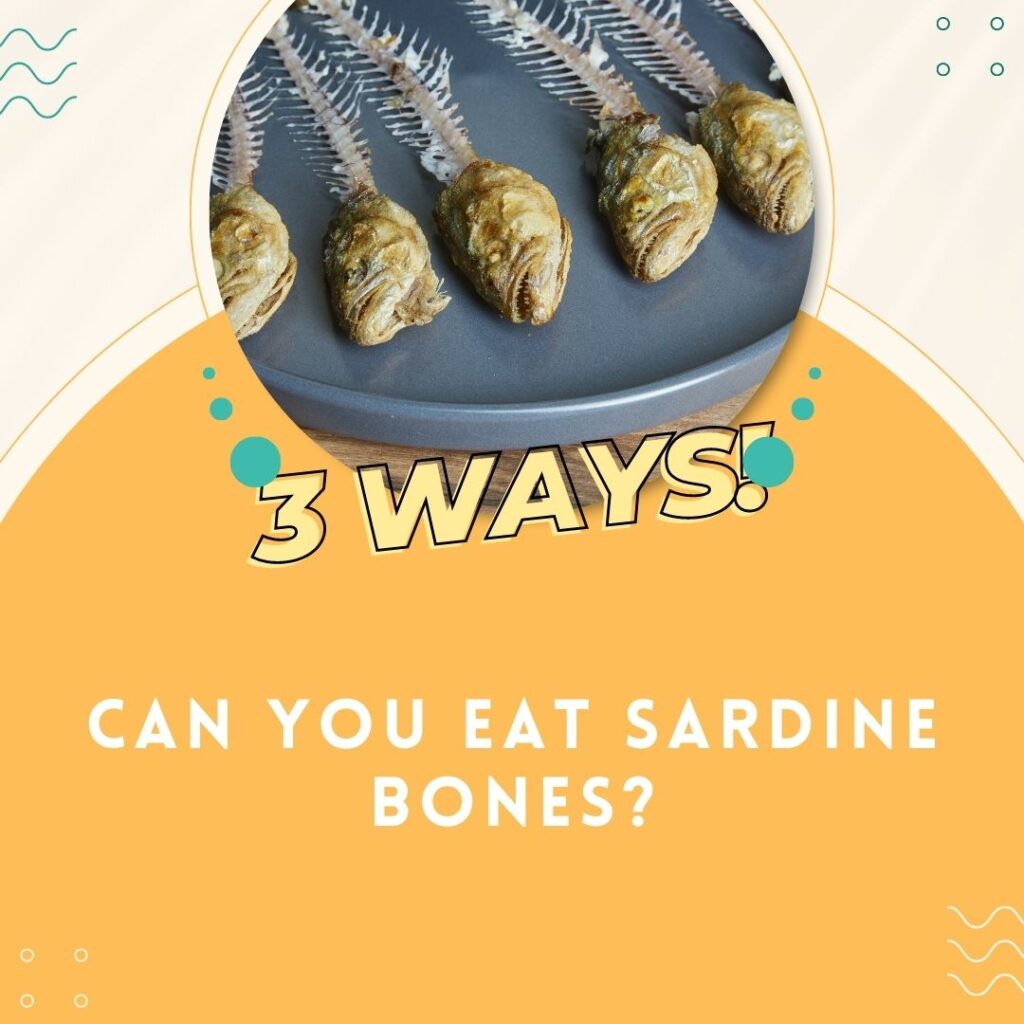Packed full of essential nutrients, Sardines are perhaps one of the most underrated fish in the sea.
This tiny, but mighty oily fish is a powerhouse of protein, Omega-3 fatty acids, calcium and vitamin D.
Economical and wholesome, sardines perfectly straddle the line between health-conscious nutrition and budget wellness.
However, there’s one element about sardines that often perplexes people – the bones.
Are they safe to eat?
In this discussion, we’ll get into the mystery surrounding sardine bones – investigating their safety for consumption as well as their potential nutritional benefits.
We’ll also offer a slew of tips and creative culinary ideas to incorporate sardine bones into your eating routines.

Can You Eat Fresh And Canned Sardine (or Fish) Bones?
A lot of people are unsure about the safety and health impact of eating fish bones, particularly sardines.
If you’re among those who often ponder over this question, rest assured that fish bones – especially from sardines – can be eaten without causing any harm, provided they are properly chewed.
A moderately sized serving of sardines, weighing around 2 ounces (approximately 56.7 grams), can provide up to 17 percent of your daily recommended calcium intake.
A good portion of this mineral value comes from the fish’s bones and skin.
When it comes to fresh sardines, it’s advisable to focus on consuming the backbone while avoiding smaller, scattered bones embedded in the meat as they may not give a pleasant texture when eaten and could potentially pose a choking risk.
As for canned sardines, there’s generally no need to worry about the spines.
The pressure-cooking process used in canning typically causes most of the bones to dissolve.
Any remaining ones are usually cooked down to a point where they turn gritty once chewed – an entirely safe and sometimes even enjoyable crunch amidst the soft fish flesh.
How To Eat (Cook) Sardine Bones
Unknown to many, there’s a world of flavorful possibilities available in the overlooked, often discarded sardine bones.
For those who dare, these little treasures can be turned into crispy snacks, nutritional boosts to your meals and even add that extra oomph! to your homemade soups.
So what are some ways you can make the most out of sardine bones?
Creating Fish Bone Crackers
Imagine enjoying perfectly cooked fish, with an added twist – artisanal fish bone crackers.
To craft these unique nibbles, begin with clean backbones (don’t worry about leaving some fillets on them; it adds flavor), set them out to dry for a few minutes on your counter.
Once dried, lightly dust them with flour and submerge in hot oil until they turn a crisp golden brown.
Simply serve these crunchy delights with dipping sauces and cool drinks as an avant-garde appetizer.
Chew On Them
If sampling sardine bones is more your style, ensure you chew on them thoroughly – akin to how you would relish an exquisite piece of dark chocolate.
This simple act allows for the full experience of its subtle flavor profile and satisfying crunch.
Brewing Up Some Flavorful Fish Stock
There’s nothing like homemade stock to imbue dishes with depth and complexity of flavor.
And guess what?
Your sardine bones can serve as the ideal base for this culinary elixir!
By simmering these bones just as you would bone-in cuts of meat, you coax out their delicious essence creating a rich broth.
This nutritious stock serves as an excellent foundation for fish soups or any recipe calling for a touch of seafood-infused goodness.
Can You Choke On Sardine Bones?
While it’s true that sardine bones are significantly softer compared to other fish species due to their smaller size, it doesn’t mean they’re completely free from posing a choking risk.
The danger typically lies in the scattering of small, often unseen bones hidden within the flesh of the sardine.
These can easily slip down the throat unnoticed if not properly chewed.
Unlike the more prominent backbone of this diminutive species – which is large enough to command your respect, causing you instinctively to chew thoroughly before swallowing – these smaller fragments can catch you off guard.
If you happen to find yourself in the unfortunate situation of choking on a sardine bone, it’s essential that medical assistance is sought immediately.
How Come You Can Eat Sardine Bones?
The secret lies in the cooking process.
For canned sardines, pressure cooking is employed to transform the bones into incredibly soft and tender constructs.
This rigorous method takes those intimidating bones and dissolves some of them, while making others so pliable that they instantly break down when chewed.
What about fresh sardines, you ask?
Even though these aren’t processed under high pressure like their canned counterparts, they still follow a similar principle.
The heat from standard cooking significantly softens the sardine bones into a soft mass that is easy to consume.
It doesn’t turn them as mushy as canning does, but it still makes them gentle enough to be ingested comfortably.
Why Are Sardine Bones So Soft?
If you’ve ever had the opportunity to dissect a fresh sardine, you might have noticed that the bones inside seem considerably softer than what you might find in a land mammal like a cow or sheep.
The difference is not so drastic that they are completely soft, there’s still some toughness to them, especially the back bones, but it’s an observation worth making.
So, why are sardine bones so soft?
Sea creatures like sardines don’t require strong bones for support in the way that land mammals do.
Instead, their skeletal system primarily aids in locomotion, allowing them to glide smoothly through water.
This fundamental difference in biological need results in sea creatures having distinctively softer bones.
When cooked, these already weakish bones turn even softer.
Some might even find them enjoyable to eat as part of the whole fish, viewed as adding a unique texture rather than posing any inconvenience.
Can Babies Eat Sardine Bones?
The answer is a resounding ‘no.’
While it may seem harmless—after all sardine bones are small and seemingly soft—the fact remains that babies lack the necessary motor skills and understanding to chew these bones thoroughly.
This can lead to accidental swallowing, posing a potentially hazardous situation.
Simply put, it’s just not worth the risk.
Babies are still exploring their world of food and learning how to handle diverse textures and tastes.
Adding something as tricky as fish bones into the mix could lead to unforeseen complications.
So by all means, let your baby enjoy the numerous health benefits of sardines but take that extra step to ensure those tiny bones are not in the picture.
Do Sardine Bones Dissolve In Stomach?
The bones of sardines are incredibly small and soft.
The moment they enter the high acidity environment of your stomach, they begin to dissolve.
This natural process aids in digestion and makes the consumption of sardines entirely safe.
Why do these tiny sardine bones dissolve easily?
It’s primarily due to their softness and size.
Unlike larger, tougher bones from bigger fish species, sardine bones lack density.
Their delicate construction allows them to break down swiftly under the potent effects of stomach acids.
Can You Eat The Heads Of Sardines?
While the idea may surprise many, the truth is, sardines are entirely edible – from head to tail.
You see, these small fish primarily dine on plants and thus have a minimal digestive system.
Consequently, there’s hardly anything to “clean” off them.
The head of a sardine can absolutely be consumed.
However, we understand that not everyone finds this part of the fish appetizing.
It might be challenging for some folks to wrap their taste buds around it – and that’s okay!
If eating the head doesn’t seem like your cup of tea, don’t toss it just yet.
Sardine heads are highly flavorful and can be used to create a rich, savory stock in tandem with the bones.
Think about it as incorporating every part of the fish and reducing waste – all while infusing your dishes with a delicious depth of flavor.

